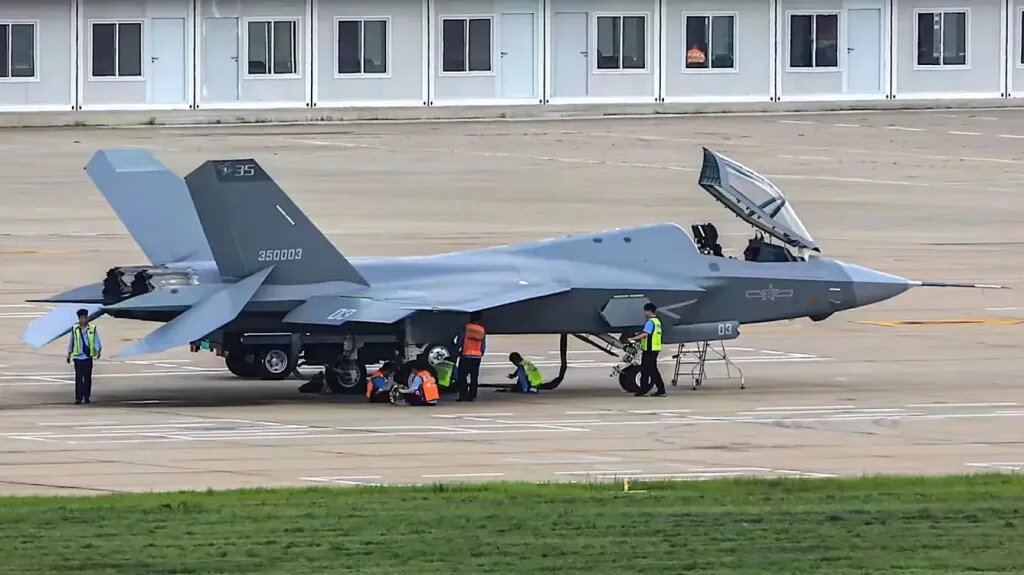A recent image of China’s stealth fighter J-35, the clearest view to date of this next-generation carrier-based aircraft, has been widely circulated. The J-35 is set to play a significant role in China’s future aircraft carrier fleet.
This image is part of a new wave of photos showcasing some of China’s most advanced military aircraft with unprecedented detail. Previously, only blurry or heavily edited images of China’s military aircraft had been seen, but this high-quality imagery is changing perceptions of the extent of China’s current aerospace and military technological advancements.
The photo, taken from an air-to-air perspective, was recently published on social media and has been almost certainly confirmed by the Chinese military or another official source. It shows two prototype J-35s flying together—one with the tail number 3501, equipped with a “pito” pod for flight testing, and another with the tail number 3506, which appears to be close to the final production model, likely featuring an onboard radar in the nose.
The exterior surface of the J-35 is smooth and flat, consistent with stealth requirements. Both aircraft have Luneburg lenses under the fuselage—radar reflectors commonly used in stealth fighters when concealment isn’t critical, or during high-density airspace operations, or even to deceive external radar systems.
Two additional lower-quality images of the 3506 aircraft also provide interesting insights. They show the rear view, giving a better look at the engines, likely indigenous WS-13E turbofans, which feature serrated nozzles. There are rumors of a possible gun muzzle above the left air intake—if confirmed, this would be the first indication of an internal gun on the J-35, a feature that could pose issues if the aircraft is a copy of the American F-35, which media often compare it to.
This view also does not reveal other advanced sensors or systems expected on the J-35, such as an AESA (Active Electronically Scanned Array) radar.
The J-35 is the carrier variant of China’s FC-31 aircraft, which first flew in October 2021. The initial prototype had a blue-green camouflage with serial number 3501. The second known prototype, numbered 3503, was seen in June 2022 painted in light gray. In September 2023, a third prototype was spotted, but low-quality images made it difficult to confirm whether it was the naval J-35 or a land-based FC-31.
Operations from Aircraft Carriers
Since then, numerous indications suggest that the J-35 will operate from China’s existing aircraft carriers—Type 001 Liaoning, Type 002 Shandong—as well as the upcoming Type 003 Fujian, currently in trial stages.
In late 2023, China unveiled a land-based version of this stealth fighter, called J-35A.
J-35 Export Prospects
It is also reported that Pakistan may be the first export customer for the J-35. In early 2024, Pakistan’s Air Force commander announced that the country is considering purchasing stealth fighters, and the Pakistani government recently revealed on X (formerly Twitter) that it has received proposals for 40 fifth-generation J-35 fighters, along with one Shaanxi KJ-500 early warning aircraft and HQ-19 air defense systems from China.
Introducing the KJ-600
Additionally, new images have emerged showing another vital aircraft for China’s future naval fleet: the KJ-600, an airborne early warning and control (AEW&C) aircraft. The latest photos depict a KJ-600 in flight, closely resembling the American E-2 Hawkeye, which performs a similar role on US carriers.
The KJ-600 made its first test flight in Fall 2020 and was developed by Xi’an Aircraft Company. With the addition of the KJ-600 to China’s Fujian aircraft carrier and other future carriers, significant advantages for the Chinese navy will be achieved: the aircraft will extend the radar range of the carrier, especially for low-altitude or surface targets, and will play a key role in battlefield management. It will coordinate fighter routes and serve as a command and control hub, integrating radar data and passive sensors for real-time operational awareness, and likely act as a data relay node.
In addition, images of another AEW&C aircraft, the KJ-3000, designed for land-based operations, have recently been released. The low-resolution images from December 2022 show this aircraft, based on the heavy Y-20 transport plane, as part of China’s expanding and diverse AEW&C fleet, which also includes several variants based on the Y-9 platform.

